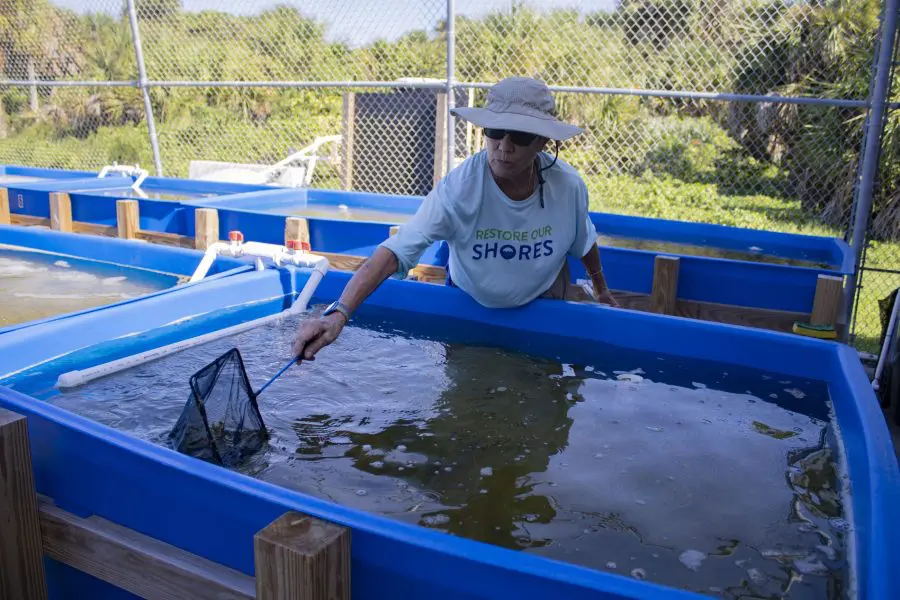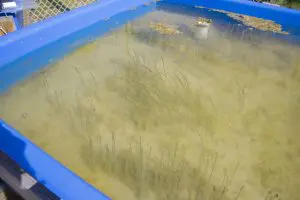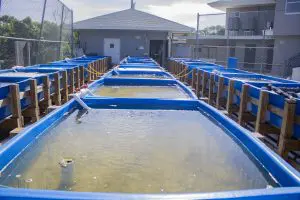

In September 2023, we shared that our first seagrass nursery was fully functional and growing seagrass. A year later, our Restore Our Shores team has made some progress – and learned a lot – with this brand-new aquaculture facility! This nursery, which was built in partnership with the Hubbs-SeaWorld Research Institute (HSWRI), is in Melbourne Beach.
For our team, it’s been challenging to learn something new: running a brand-new aquaculture facility, said Olivia Escandell, Senior Conservation Manager. Still, it’s been rewarding to watch the small fragments of Halodule wrightii, or shoal grass, our team gathered (with a permit) from the lagoon grow into rooted seagrass. Collection from some spots has even been plentiful as seagrass is recovering in portions of the lagoon. “We had thought starter stock was going to be hard to find, but we have been very thankful for plentiful fragments from the north Indian River Lagoon and Banana River,” Olivia said.
 Our team has learned a lot of new skills and developed deep partnerships with other seagrass-growing organizations brought together by the Indian River Lagoon NEP as well as our hosts at Hubbs Seaworld Research Institute who have helped us tremendously through the early stages of this project.
Our team has learned a lot of new skills and developed deep partnerships with other seagrass-growing organizations brought together by the Indian River Lagoon NEP as well as our hosts at Hubbs Seaworld Research Institute who have helped us tremendously through the early stages of this project.
“It has also been really fun to work with new volunteers at the nursery who care just as much about the seagrass as we do,” Olivia said.
Through this process, we’ve learned how resilient seagrass can be during periods of stressful conditions like low light and low salinity. Despite those periodic changes, our Halodule wrightii plantings still grew!
“We’ve also been able to observe seagrass growth and stress behaviors very closely,” Olivia shared. “Even knowing what it looks like when stressed seagrass loses its blades in the nursery has made us observant of seagrass growing in the field as we check for the same patterns and behaviors.”
 We completed construction a little later in the season, not making it possible to supply our spring planting projects – but we were still able to support several experimental research projects with grass from the nursery!
We completed construction a little later in the season, not making it possible to supply our spring planting projects – but we were still able to support several experimental research projects with grass from the nursery!
Another hiccup along the way: the failure of our original recirculating pump, making it necessary to retrofit a new one. While we’ve been dealing with various epiphytes, algae blooms, and cyanobacteria seasonally that grow on the grass blades and reduce sunlight from reaching the grass. This has made maintenance laborious for staff and volunteers. A new UV sterilizer has helped us clear the tank water quickly and improve growing conditions for the grass.
Next up for our nursery: The construction of a shade structure to help protect our filtration and reduce water temperatures in the system during summer’s peak. We will also be continuing to troubleshoot the algal bloom and epiphyte issues, potentially using helpful native invertebrates like amphipods and snails that may help keep the seagrass blades clean. The team will also be trying to establish a new seagrass species,Syringodium filiforme or manatee grass, to the system which will diversify the stock of seagrass available for future restoration efforts. .
“If all goes well, the nursery will produce lots of seagrass that we can use on our planting projects in 2025,” Olivia said.
Special thanks to Hubbs Seaworld Research Institute for providing the Zoo with the space for the nursery as well as additional resources. We also appreciate the Indian River Lagoon National Estuary Program and Zoo donors for supporting the seagrass nursery.
“Very important thank you as well to the many ROS staff, other Zoo staff, and volunteers who have helped conceptualize and construct the nursery, clean and maintain the nursery tanks, and spend time troubleshooting new challenges in the nursery,” Olivia said. “It’s not easy being green.”
Special thanks to Flammio Financial Group, Stifel-Garvin Wealth Management Group, Artemis IT, and Jim and Darleen Barfield. Their generosity makes our work possible!
Brevard Zoo is an independent, not-for-profit organization that receives no recurring government funding for our operating costs. Your generous support enables us to continue to serve our community and continue our vital animal wellness, education and conservation programs.